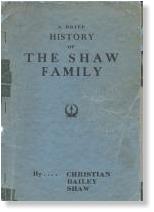
By Christian Baily Shaw
Originally published by The West Plains Journal Company, Inc., West Plains, Missouri, 1939
Reformated for the Internet with additional graphics and index by John Daniel Shaw - 2006
To the original early history of 1932
Four years ago when standing before you in Highland Park of Kokomo, I made the statement that it had been just one hundred years ago at that very time since the first ones of our family of Shaws had made their advent into the then new State of Indiana. In talking with some of the younger members of the family some time after the reunion, they remaked that they would be glad if some of the older ones would write down some facts like that so that some little history of the family might be preserved for them and future generations. And I might also say that I would have been very glad, indeed, if some one before me had written some things that I would like to know and which I have no way of finding out. However, having this in mind I began a correspondence with persons in the home country in North Carolina, from which the family had made its exit on going to Indiana, and I have received a very interesting chain of communications from different parts of that State and from different parts of Missouri, Oklahoma, Iowa, and the State of Washington. So from these sources and what I know and remember hearing my father and other older ones relate, I shall write down some of these facts.
And in writing this little resume of the history of the Shaw family. I have been guided by the fact that brevity is often more to be preferred by the reader or the listener than the long-drawn-out story. And I have been hampered by the lamentable fact that you can not write authentically and entertainingly about things of which you have but little knowledge. What we know comes from only two sources: First, that which we perceive first hand through our own senses, and second, the knowledge we receive from others through conversation or from the written or printed page. I have been away from those about whom I write for so many years, and memory is never faultless, that many interesting experiences may have been omitted. So, for the foregoing reasons, this article is necessarily brief and only down through my own generation.
I would suggest that, if you care to, you have some one who is near there and who can get the necessary facts more easily, appointed as historian, and have the history of the family brought down to date. It would be interesting, and I trust helpful, to those living now and also to future generations.
With the most profound reverence for the memory of those departed and with the greatest love and best wishes to all the living, this brief outline is offered by,
| PREFACE To the revised and completed history of 1938 |
THE WRITER.
West Plains, Missouri, July 14, 1932.
The following matrix was initially compiled from the oral histories of the Shaw family in 1939. On March 7, 2006, I received more information from Linda Tillman which she had researched using records from both genealogical societies in Surry County, NC, and Henry County, IN, as well as other sources. That information is shown in the lighter text color and was either not in the oral histories or was different.
On July 4, 2008, Rebecca Ann Shaw in Texas gave a great boost to this research by providing information on our eldest of forefathers taking us back to Glasgow, Scotland.
The darker yellow boxes indicate direct family lines. Underlined names are links to more information and extended family trees.
Birth: ~1700 Scotland |
||||||||||||||||
Birth: 1722 in Glasgow, Scotland |
||||||||||||||||
b:1754 in Guilford County, N. C. Surry Co. 1790 Census & 1775 Tax Rec. 2 male children < 16 & 1 female m. Elizabeth Masters d: 1810 |
William Hance Shaw, Sr. b: 6 Apr 1748 in Guilford County, N. C. d: 22 Feb 1814 in Christian, KY m: Ann Allison 19 Apr 1774 b: 1758 Guilford, NC 1800 Surry Co. Census NSDAR #566799 Records Page 1 2 3 4 |
Finley b: 1752 in Guilford County, N. C. m: Eizabeth McBride 1785 in Guilford Death: Guilford County, North Carolina |
Samuel b: 1750 in Guilford County, N. C. d: 1805 Abbeville, SC. m: Mary Morris(on?) 7 Dec 1774 Surry Co. Tax Tables 1771-75 |
|||||||||||||
b: 9 Dec 1785 Surry Co., NC d:18 Nov 1856 Henry Co. Indiana Surry Co. 1810 Census m. Mary Carter 1804 b. Chatham NC, d. 1832 - Henry Co., Indiana remarried Lucy Hinshaw buried in Henry County, Chicago Corner Cementery 6 children listed in the 1820 Surry County, North Carolina Federal Census |
William H
b. abt. 1775 NC d. 1840 Economy, Indiana m. Mary Bingham, b. abt. 1760 sons - Benjamin, Nicholas, Daniel daughters - Elizabeth, Nancy, Susannah 1893 Map of Economy, Perry Township, Wayne County, Indiana Property maps 1874 vs 1893 |
|||||||||||||||
| Isaac Vinton 1804-1868 m. Nancy Witaker 1826 Another source |
William2 (1816-1898) m: Catherine Bernard 1838 Went West |
Elizabeth "Betsy"3 |
John (1818-1905) Went West |
James 1810-1881 Millville |
Calvin | Henry | Charles Went West |
Polly | ||||||||
| William Riley b: 1836 d: 28 May 1864 m: about 1857, to Louisa Butcher Civil War Record b. Madison County, Indiana d. Andersonville, georgia |
John W. b: 1830 d: 1925 m: Martha Riggs |
Nancy A. 1839 |
Isaac Vinton, Jr. (Brown Twp, Hancock Cty, Indiana) was farmer. Enlisted, with one of his brothers William Riley Shaw, in the 99th Indiana Infantry, Company B on 13 August 1862. Per pension (12 March 1869 to his mother), he died of chronic "camp" diarrhea at a field hospital in or near Marietta. |
Mary M. 1832 |
Beal Butler b: 4 Jul 1836 d: 11 May 1911 Logansport, Cass County, Indiana |
James Calvin b:1828 Surry Co., NC d: Apr 1901 m: Eliza Manning, then Margaret Fritz Oct 1865 |
||||||||||
| John Walker b:1860 d: 1928 m: Minnie F. Pyle 6 Dec 1884 John Walker Shaw (son of William R. Shaw and Louisa E. Butcher) was born August 26, 1860, and died April 27, 1928 in Tipton, Indiana. He married Minnie F. Pyle on December 06, 1884 in Russiaville, Indiana. More About John Walker Shaw and Minnie F. Pyle: Marriage: December 06, 1884, Russiaville, Indiana. < http://familytreemaker.genealogy.com/users/c/r/a/Nora-Crauthers/WEBSITE-0001/UHP-0812.html |
Sarah 1858 |
Elfa J. 1862 |
||||||||||||||
| Arnell E. (Jack) b: 1892 - 1959 m: Barbara Anna Suvers 1891 - 1945 Minnie Pyle 1868 - 1941 |
Maud Ellen 1885 |
Mabel Dell 1898 |
Ruby Grace 1901 |
Ural Sylvester | ||||||||||||
| John Richard 1914-1987 buried in Tetersburg, IN m: Francis Helen Lednum December 25, 1937 d: 2010 |
Freda | Nedra | ||||||||||||||
| John Daniel b: January 5, 1944, Tipton, IN m: Cheryll Ann Thompson 1966 then Phyllis Hope Cassada June 7, 1975 Halifax, VA |
Susanne b: August 2, 1940, m: John Letsinger d: 2008 Ashes scattered in her flower garden, Tipton, IN |
Christy Gay b: July 5, 1942 m: David Tragesser then Jim Schroeder |
||||||||||||||
| Adrian Kelly b: September 15, 1968, South Boston, VA m: Deanne Helena Powell May 18, 1991 Danville, VA b: November 18, 1969, South Boston, VA
|
Ericka Christin b: July 10, 1970 South Boston, VA, m: Clay Farrell February 1999 then Steven Caruso July 11, 2004
|
|||||||||||||||
1Mary was called Polly in the Shaw Family History book. "She went to Missouri, married Isaac Hobson and then a Breneman. She was in Missouri in the 1850 census. Might have found her there in 1870, Believe she had 6 children." per Linda Tillman
2William married Catherine Bernard 1838 in Henry Co. and went to Iowa.
Betsy3 is known as Elizabeth (~1814-1892) in the Tillman research. She married Henry Nicholas and was buried in Henry Co., Indiana
Nestled among the foothills on the eastern slope of the Blue Ridge Mountains, in western North Carolina, with the State of Virginia on its northern border and the Yadkin River bounding it on the south, lies Surry County. Just across this river to the south is the neighboring county of Yadkin. The roots of our story are planted in these two counties of North Carolina and the branches shall bud forth as we proceed in time, place and events.
About the beginning of the second century before this, (1700), there began a steady flow of immigration to this plateau region east of these mountains of which these two counties are a part. Hither came the oppressed from the mother countries of Europe, mainly the Germans, the Dutch from Netherlands or Holland, the , Welsh, and the Scotch-Irish from Ulster, as well as the overflow of English from the older settlements along the coast. Among these early immigrants are three families of which we shall especially write who make the sturdy stem of the tree planted in this Southland, the family of Shaws, the family of Masters, and the family of Whitakers.
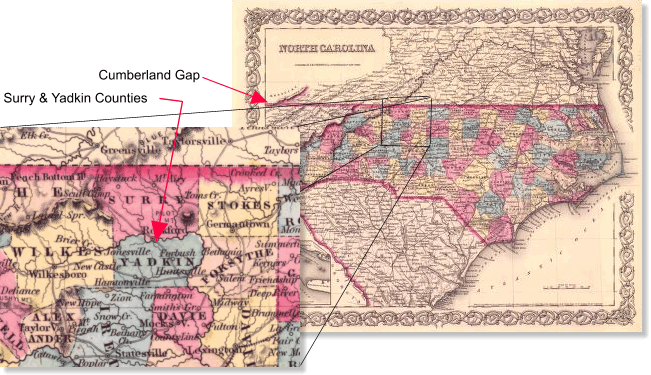
1854 North Carolina map showing the counties along the norther border with Virginia. Cumberland Gap is at the western tip of Virginia.
Yadkin County was formed in 1850 from Surry County, south of the Yadkin River, from which it was named.
About the time a new nation was born on this side of the Atlantic, near the close of the century before spoken of, a sturdy boy baby was born (about 1790) in the Shaw family whom they named the Biblical name, Isaac. This name has been perpetuated in the family until now, one of the best men living bearing it as his middle name, James Isaac Shaw of Kokomo, Indiana, of whom we shall later write.
|
The following information was received from Linda Tillman on March 6, 2006: Ralph Shaw (born 1784) married to a Mary Carter. Their children were Isaac (born 1804), James, Elizabeth, William, John, and Mary. Ralph and Mary ended up in Henry Co., Indiana. But I believe he didn't follow to Henry Co. William and John did go to Iowa. I have come across where they say that an Isaac was married to a Masters, but I believe that there was a James Shaw married to Masters and they were the parents of Ralph Shaw who came to IN. I was in contact with another Shaw researcher and we did alot of work with trying to find the parents of Ralph Shaw. We never came up with anything. The only thing we could use to come to the conclusion that the father was James was the census. Also we believe that Ralph had a brother named William that also came to IN. I haven't looked into Isaac's family much other than what I have seen in other postings. I come through his brother John and his first wife. His oldest son didn't go to Iowa with the family, but rather stayed in IN. Linda |
About the same time Isaac was born, a winsome girl baby was born in the Masters family whom they were pleased to call Molly. As time went on these two grew to manhood and womanhood. Isaac casting about for some one to bake his hoecakes, spin, weave and make his clothes for him in a home of his own, met Molly at a neighborhood gathering or perhaps at church a few miles away, or maybe she was a near neighbor. As he courted her, he would take her places on foot or on his favorite steed, mounted on the croup behind him, or on an extra horse with a side saddle, her clothing and limbs protected from soiling and sight by the long, flowing riding skirt worn by ladies in those days when riding. At that time it would have been almost sacrilege to see a lady mounted astride or to see her limb above her ankle.
Well, Isaac, dressed in his clean home-spun or in his buck skin clothes, mounted on his prancing steed or on foot, whichever it may have been, won Molly's heart. They were married about the beginning of the century before this, which would have been about 1800, and set up to house-keeping.
As the years went by they became the parents of nine children: Calvin, Isaac2, Henry, Polly, James, Betsy, Charles, John and William, all born in Surry or Yadkin Counties, North Carolina. This second Isaac became the sturdy stem of this family tree about which it shall now be our pleasure to write. He was born in 1804.
Three years later, 1807, a tiny girl baby was born in the Whitaker family. Her parents named her Nancy Ann, a name which many of the female members of the family have borne. About the year 1826, Isaac Shaw, the second, and Nancy Ann Whitaker had grown to manhood and womanhood and were married in Surry County. As this was in the region of small farms and small farming, they remained there, raising their corn and vegetables and getting their fruit from the woods and their meat from the wild game or from their pigs that ran free in the forest, until the fall of 1828. During these two years, their first born son came to claim his home with them, James Calvin, born January 31, 1828, the father of the writer.
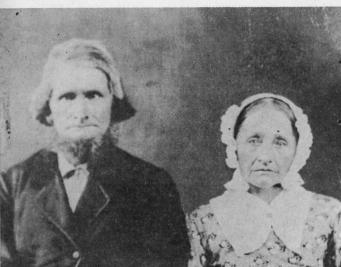 Isaac and Nancy Ann (Whitaker) Shaw About 1865 |
About this time, a great unrest was taking place among these settlements of small farmers on the frontier of the West, as the larger plantations near the coast were taking the lead in the government to the exclusion of the smaller western settlements. Also, the great scope of country northwest of the Ohio River and extending west to the Mississippi, had been organized some years before this by the "Ordinance of 1787."
Indiana had been carved out of a portion of this territory and made a state of its present limits in 1816, with the capital at Corydon, near the Ohio River. Parties of some means had made the trip on horseback from North Carolina, through the forest trails, a distance of about five hundred miles, to these new lands and brought back almost fabulous stories of the rich soil and the wonderful opportunities to be found there. To these people the stories were very true as the soil on their native slopes and hills was becoming worn and much depleted.
Accordingly, in the fall of that year (1828), Isaac and Nancy Ann, with their little son, much less than a year old, and with Isaac's younger brothers and sisters and other parties who had joined in with the undertaking, loaded their old Conestoga covered wagons with what belongings they could take along. These wagons were made with longer axes so the wheels could be set further apart to prevent their toppling over so easily on going over the rough mountain roads. The belongings they took along consisted mostly of wearing apparel, bedding and some of the scanty cooking utensils they usually had in their cabins in those days, axes, of course,and probably hoes were tied on some place so they could have them to dig up the ground for crops in season, as you could not so easily run to the store and buy them if you had the money, and they probably didn't have it, and they surely didn't forget the tar bucket but swung one on each coupling pole, and far from them forgetting the trusty old flintlock and the butcher knife, for they must live out of the forest and protect themselves against wild animals and maybe, Indians.
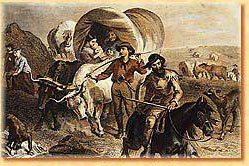 Let us pause and think a moment. It surely took stout hearts to bid relatives and old friends goodbye, for such a journey usually meant no return, and in their case it proved to be true for as far as we know, none of the party ever returned to their native state.
Let us pause and think a moment. It surely took stout hearts to bid relatives and old friends goodbye, for such a journey usually meant no return, and in their case it proved to be true for as far as we know, none of the party ever returned to their native state.
Everything being put in readiness, they bade their relatives and friends this last sad good-bye, clambered into the wagons, those of them who rode, and moved slowly and sadly away on their long and tiresome journey. Those who were able took turns in walking so they might have the exercise and to lighten the load for those old wagons pulled heavily, and to rest by the change. They crossed the Blue Ridge Mountains first, then through the valley west of them, and on westward until they reached the Cumberland Mountains on the border between Virginia and Kentucky, then through the Cumberland Gap into Kentucky. From there, they took a northerly course, a good part of the way through the famous Bluegrass Regions of Kentucky, until they reached the Ohio River at Cincinnati. Here Grandmother, as we shell hereafter call her, although at that time she was only twenty-one, always declared they had to leave a good part of their belongings as there wasn't a flatboat large enough there to carry all their goods over, making them scarce of things with which to go to housekeeping when they reached their destination. Being across the river, they continued their journey northward, bearing a little to the west, for several days more until they finally stopped their caravan in the neighborhood of the little settlement of Economy in the western edge of Wayne County, and only a few miles east of Newcastle, Henry County, Indiana. (See this 1828 Indiana counties map)
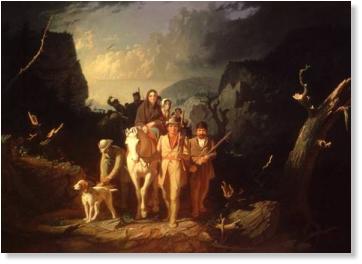 In 1775 a North Carolina trading company hired Daniel Boone to establish a road to Kentucky. After clearing the Wilderness Road, Boone escorted parties of settlers to Boonesborough where he had built a fort. Here, he leads travelers through the Cumberland Gap. |
Some members of the party remained here in Wayne and Henry Counties for several years. Tradition tells us that Isaac's brother, Charles, went West when he was seventeen years old and the family never heard from him again, and we have been unable to find out anything about his brothers, Calvin and Henry and his sister, Betsy. His sister Polly was married and went with her family to Missouri, where they lost trace of her. His brother, James, settled near either Middletown or Millville, Henry County, and spent the rest of his life there. So far as we know, he left no family. His brothers, John and William, went on west in an early day and settled near Clarksville, Butler County, Iowa. Some of their descendants still live there.
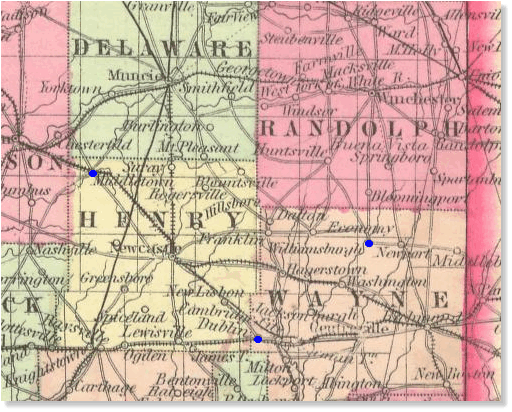
This 1856 map, Colton's Indiana, shows Economy in Wayne County where the family first settled
and Middletown in Henry County where brother James settled.
Also marked is Dublin, the birthplace of Frances Helen Lednum, future wife of John Richard Shaw.
Isaac and Nancy Ann had six more children born to them after coming to Indiana: John W., March 4, 1830; Mary M., January 14. 1832; Bailey B., July 4, 1836; William R., about 1838; Nancy A., October 7, 1839: and Isaac R., about 1841. They were all born in either Wayne, Henry or Madison Counties, where they had lived in their drift to newer lands further west. Isaac was of that sturdy, fearless, upright stock, qualities so essential in the pioneers of that day. His son. James Calvin, has told us so many happenings in his life indicating his fearlessness, his integrity and his native wisdom. Nancy Ann was small of stature, wiry, vivacious, making them an admirable pair to cope with the difficulties of that primitive period. He made a living for himself and his family with his ax and his saw, maul and wedge, combined with a little farming. He laid up no monetary wealth, but he left a rich legacy of a family of five sons and two daughters, all upright, honest and God-fearing men and women—a wealth that far exceeds all the gold you can pile up.
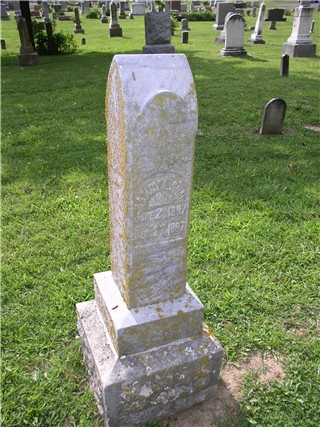
|
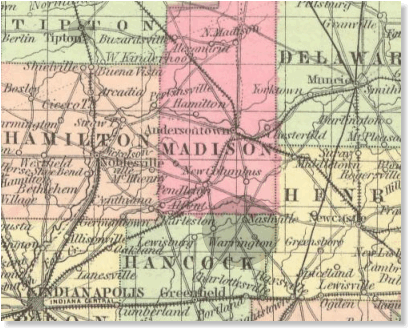
This map shows the final resting place for Isaac in southern Madison County(? - Hancock County) and Nancy A., who made her home almost continuously with the family of her daughter, Nancy, who had married Joseph Garrett, and lived only a few miles away in northern Hancock County, near Warrington and Wilkinson. Tipton, shown in the top left, is the 1944 birthplace of John Daniel, son of John Richard and Frances Helen Shaw. |
|
| July 28, 1868 |
||
| Harlan Cemetery, Handcock County, Indiana |
||
| Link to Grave marker |
This sturdy old stem of our family tree bowed to the earth and his spirit went to the God who gave it at his home in the southern part of Madison County, in July, 1868. He was taken rather prematurely at the age of sixty-four, his death being largely due to a hurt he had received some time before. After his death, his faithful life-partner, Nancy A., made her home almost continuously with the family of her daughter, Nancy, who had married Joseph Garrett, and lived only a few miles away in northern Hancock County, near Warrington and Wilkinson. Although small of stature, she had a wonderful constitution and lived to the good old age of nearly ninety-one. She passed away at the home of her daughter in December, 1897, nearly thirty years after Isaac's death.
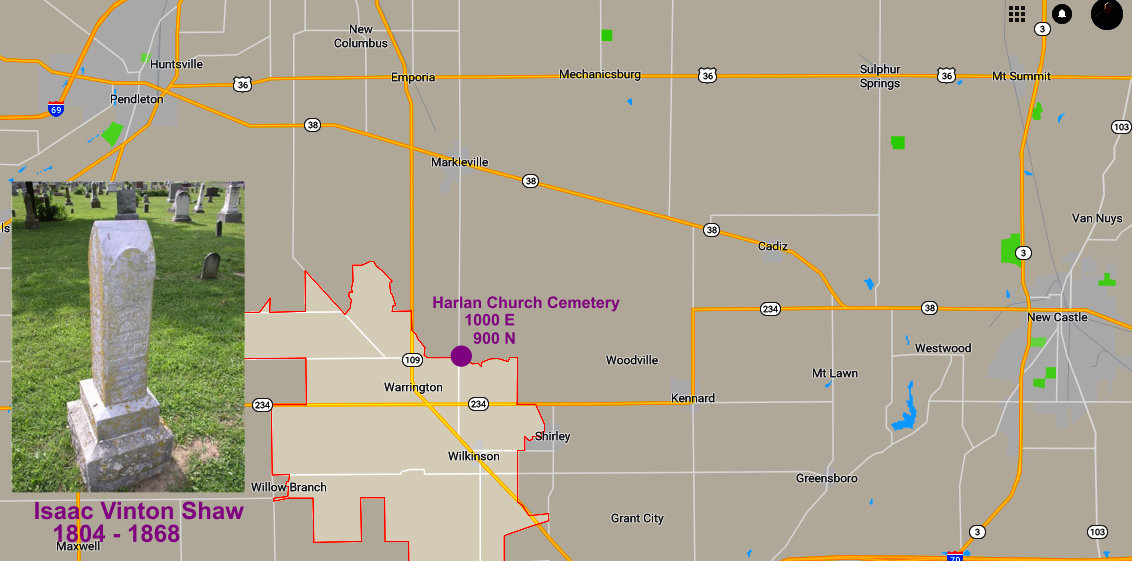
Last update February 9, 2019
Comments welcomed. Contact John Daniel (Dan) Shaw
Halifax, Virginia